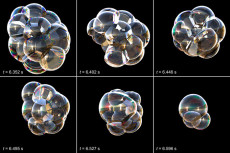Saye and Sethian’s Bubble Visualization Honored by 2013 Visualization Challenge
February 7, 2014
A visualization created by Berkeley Lab mathematicians Robert Saye and James Sethian of soap bubbles bursting and reforming has won honorable mention in the 2013 International Science and Engineering Visualization Challenge. The 2013 Visualization Challenge was sponsored by Science magazine and the National Science Foundation.
Their visualization is strikingly realistic, with the surrounding reflected in the bubbles’ surfaces. The surfaces also quiver as the bubbles burst one by one and reform into a smaller and smaller cluster. Saye is a member of the Computational Research Division’s Mathematics Group, which is led by Sethian.
This is the eleventh year of the Visualization Challenge, which “honors the long tradition of using illustration to communicate the complexities of science, engineering, and technology to students and the public.” The 2013 challenge drew 227 submissions from 12 countries, including entries from 17 U.S. states and Canadian territories.
“We were delighted by this year's responses,” wrote NSF’s Judith Gan and Science News Editor Tim Appenzeller in their introduction to the awards. “The best of the submissions are both beautiful and captivating, able to excite popular interest in subjects normally treated with academic rigor.”
The entry by Saye and Sethian was one of three winners in the Posters category. Saye and Sethian said that many people assume that the image is a photograph of bubbles, not a scientific visualization. Watch the visualization.
“Naturally we are eager to point out that it is in fact a visualization of a physics computational model,” said Saye, who recently completed his Ph.D. with Sethian at Berkeley Lab and the University of California, Berkeley.
As noted in the awards announcement, “Predicting how bubbles in a foam rearrange and rupture is a tough modeling problem, because it involves intricately coupled processes that operate at very different scales. The soap films are only micrometers thick, while the gas pockets themselves might be centimeters across. Meanwhile, individual films rupture in milliseconds; bubbles rearrange in a fraction of a second; and liquid inside the film drains over tens of seconds or longer.”
Running a simulation at the smallest scales to predict the macroscopic effects would eat up vast amounts of computer power. "Instead, we found a way to separate distinct time and space scales, and allow these to communicate so that the most important physics affecting foam dynamics are captured," Saye says. The model could be useful in devising lightweight materials or optimizing industrial processes.
An article about the model was published in the May 10, 2013 issue of Science.
The honor marks the second award for the work by Saye and Sethian. They won the 2011 Cozzarelli Prize for the best scientific paper in the category of Engineering and Applied Sciences. Their winning paper, “The Voronoi Implicit Interface Method for computing multiphase physics,” described the mathematics and interface algorithm behind the model.
Read about the other winners of the 2013 Visualization Challenge.
About Computing Sciences at Berkeley Lab
High performance computing plays a critical role in scientific discovery. Researchers increasingly rely on advances in computer science, mathematics, computational science, data science, and large-scale computing and networking to increase our understanding of ourselves, our planet, and our universe. Berkeley Lab’s Computing Sciences Area researches, develops, and deploys new foundations, tools, and technologies to meet these needs and to advance research across a broad range of scientific disciplines.







 Instagram
Instagram YouTube
YouTube